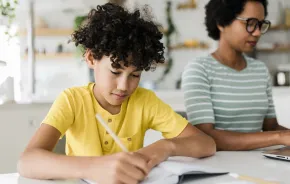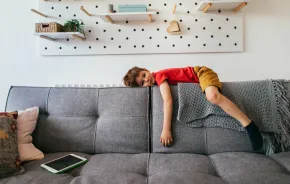
If you have a kid, they have, want or have heard about the Pop It! toy. Pop It! fidget toys are everywhere this year, and the craze stretches across the globe. But these silicone bubble gizmos are more than just toys. They are also effective anxiety management tools that can help reduce some kids’ stress and anxiety.
While dealing with feelings such as stress and anxiety is a challenge for all kids, some kind find it really overwhelming. Emotionally intense kids can find it harder than others kids to deal with anxiety-provoking situations. This means that they may struggle harder to adapt to new environments, have difficulty with separation or get overwhelmed by situations that other children seem to more easily take in stride.
Over the past few years, anxiety-reducing toys such as fidgets and chewelry have been touted as effective in helping children struggling with stress and anxiety. They are thought to provide sensory input that has a calming effect on anxious or distracted children. While the studies about the impact of such toys on children’s behavior are still few and rather inconclusive, some researchers suggest that fidgets can help calm children and improve their self-soothing skills. In other words, fidgets and sensory toys can be therapeutic, meaning that they can help your child manage their stress and anxiety more effectively. So how do you choose the best fidget and sensory toys for your child?
A guide to choosing the right fidget and sensory toys
Manipulating fidgets can help distract your child from their anxiety, but choosing the right fidget depends on your child’s fidgeting habits and where they will use the fidget toy. While some fidgets may work for kids who have trouble keeping their hands still, others will work better for kids who bite their fingernails.
Choosing the right fidget also depends on the sensory input that works best for your child. Some children need things that they can squeeze, others need things that they can hit and others still need things that they can chew on. Here are a few recommendations depending on different children’s needs.
1. Toys for kids with busy hands

Some children have a constant need to touch things. This could mean arranging all their pens and papers on their desk, tying and untying their shoelaces, or even cutting up tiny pieces of paper that they sprinkle all over their desks. For such kids, fidget tools that keep their hands busy can help them receive the sensory input they need and therefore to calm down.
Tools that keep your child’s hands busy pushing, stretching or pulling such as Monkey Fidgetz or these smiley stretchy men can help them release stress. Squishy balls or Thinking Putty are also great for such kids, even in a classroom setting, because they encourage squeezing and kneading.
2. Toys for kids who need to keep their mouths occupied

Different kids fidget in different ways. Some children need oral stimulation to relax. These are the children who are always sucking their hair or their clothes, biting their fingernails or chewing on their pens and pencils. Classic or more colorful chewable pencil toppers, or even silicone chewelry are great options for such kids who need oral sensory stimulation. If your kid is older, sugar-free gum is an affordable option they’ll more readily agree to enjoy!
3. Fidgets for children who can’t stop moving their feet
When some kids are anxious, they find it difficult to keep their feet still. These are the children who constantly need to kick or tap their feet. A Fidget Band is a great fidget tool for such kids because it allows them to fidget with their feet (kick, tap, bounce, etc.) when seated and thus enables them to focus on things other than their anxiety.
4. Fidget toys that you can take to school
Many fidget toys have been banned from classrooms because they either distract the children using them or distract their classmates. The best classroom-friendly fidget toys should be small and relatively silent.

If you feel that your child needs a fidget tool that they can use in class, keychain bubble wrap pop fidgets, and Fidget Bean Toys are discrete tools that can easily fit in their hands and in their pockets. Keychain fidgets are also practical because your child can hook them onto their pencil cases, their bags or even their belts!
When considering fidget toys your child can use in class, choosing something that they also need in class every day serves a double purpose of being useful and calming at the same time. For example, kneaded erasers are a great choice for anxious kids because your child can knead them, squeeze them or pull on them to reduce their anxiety, and they also need them in class.
5. Fidgets your child can take anywhere
Bubble sensory toys are relaxing and colorful tools your child will enjoy using everywhere. You’ll love this variety pack option which proposes different types and sizes of fidget toys that your child can pop both in school and at home.
A fidget spinner is another tool that is still quite popular and effective. Metal spinners are more costly but they are also more durable. If your child will also take the spinner to class, skip the spinners that are too flashy or too noisy.
As with most things, trial and error is the key to choosing a successful fidget tool for your child. Try out different fidgets to see which one works best for them. Let them choose the ones that they find attractive. The more your child appreciates their fidget tool, the higher the chances that it will be more effective.











